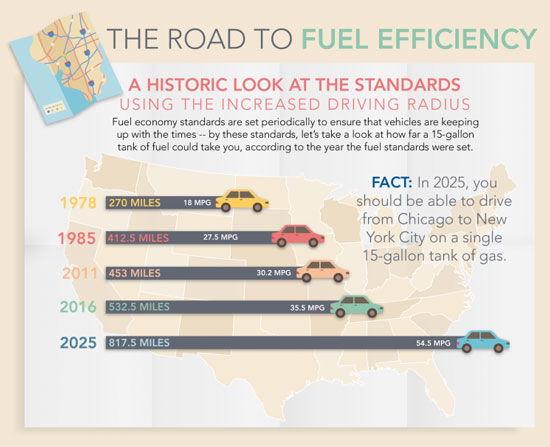| Nov 28, 2012 |
54.5 MPG and beyond: Fueling energy-efficient vehicles
|
|
(Nanowerk News) For many, refueling their vehicle can be disappointing. It’s the only activity where consumers watch the cost add up, dollar by dollar, quickly eating up disposable income. And much of that money goes right out the tail pipe -- only 14-26 percent of the energy from fuel is used to move a vehicle down the road.
|
|
The Obama Administration’s new national fuel economy standards for passenger vehicles will improve vehicle efficiency and save Americans money at the pump, all while reducing our dependence on foreign oil and growing the U.S. economy.
|
 |
| This infographic looks how new fuel economy standards will save Americans money at the pump, reduce our dependence on foreign oil and grow the U.S. economy. Click here to view the full infographic. (Infographic by Sarah Gerrity)
|
|
Finalized in August, the new standards build on the Obama Administration’s first set of fuel economy increases -- the first increase since 1985 -- that raised the average fuel economy of passenger vehicles to 35.5 miles per gallon by 2016. Under the new rules, cars and light-duty trucks built for model years 2017-2025 are expected to achieve industry-average fuel efficiency equivalents of 54.5 miles per gallon by 2025 -- nearly double the efficiency of cars on the road today.
|
|
These changes in vehicle efficiency will directly benefit consumers. By 2025 Americans can expect to save an estimated $8,200 in fuel costs over the lifetime of a new vehicle -- or almost four years worth of gasoline costs for the average household. The standards will also help clean the air we breathe, reducing greenhouse gas emissions by more than 65 percent compared to cars in 2016 and cutting other pollutants that cause soot and smog.
|
|
While the standards are based on an industry average fuel economy goal, a manufacturer’s individual requirements depend on the vehicles it produces. This helps preserve consumer choice, meaning Americans can still buy the vehicle that best fits their needs. Consumers don’t have to wait until 2025 to start saving. They are already seeing more efficient vehicles in the showrooms as a result of President Obama’s first round of fuel economy standards, and consumers are responding positively. The average fuel economy of new cars sold in October reached an all-time high of 24.1 miles per gallon, according to the University of Michigan’s Transportation Research Institute.
|
|
Improving light-duty vehicle fuel economy is also one of the fastest ways to reduce our dependence on foreign oil, helping to build an American economy to last. The program will save an estimated 12.2 billion barrels of oil, and by 2025 the standards will cut oil consumption by an estimated 2.2 million barrels a day. The fuel economy program alone with get us more than halfway to President Obama’s goal of cutting oil imports by a third by 2025.
|
|
Currently there is a wide range of technologies available to help automakers meet the standards, but achieving these historic goals will also require innovative new technologies and manufacturing. This innovation will spur economic growth and create high-quality domestic jobs. Employing 700,000 Americans, the auto industry is the lifeblood of U.S. manufacturing, and the Environmental Protection Agency estimates the new fuel economy standards will create more than 148,000 jobs from 2017-2025.
|

